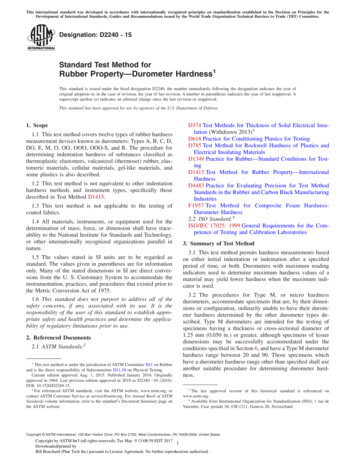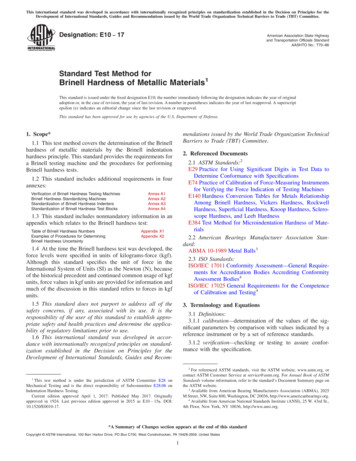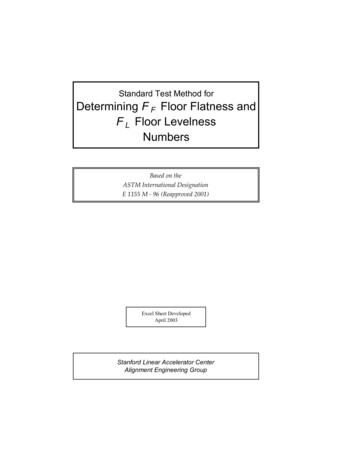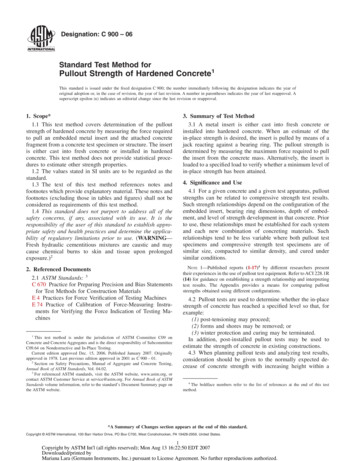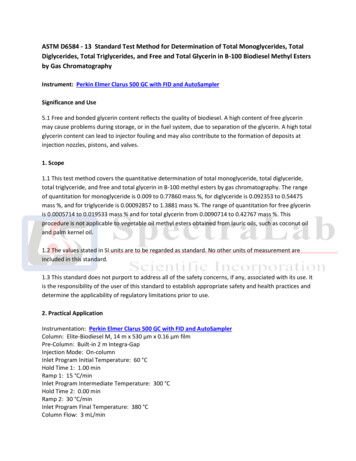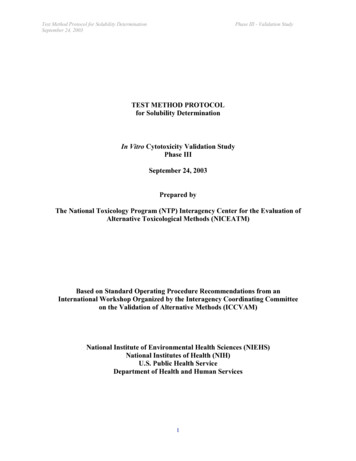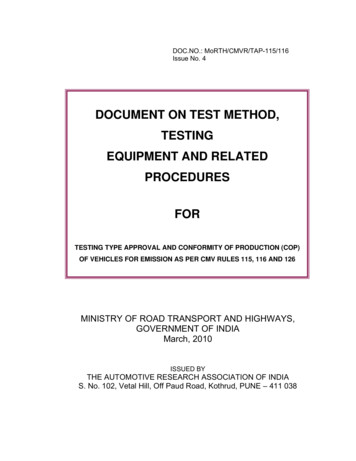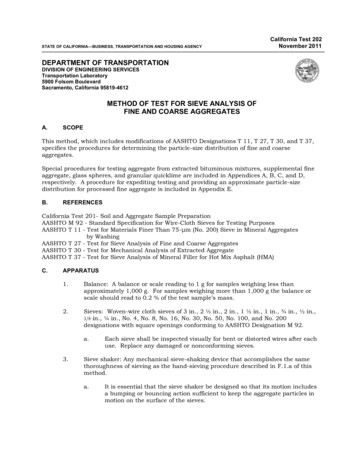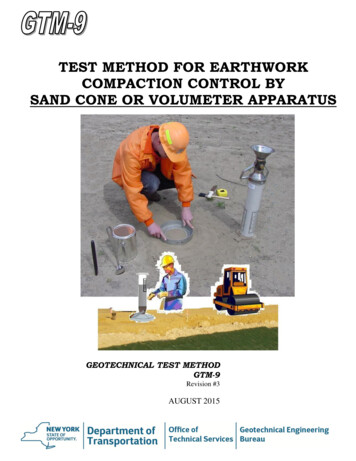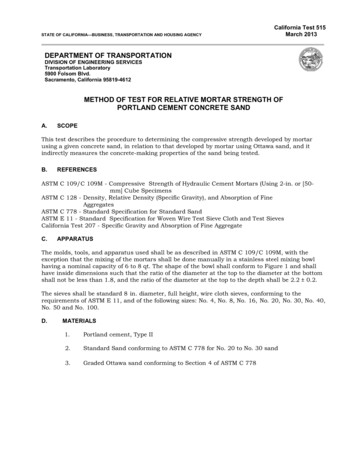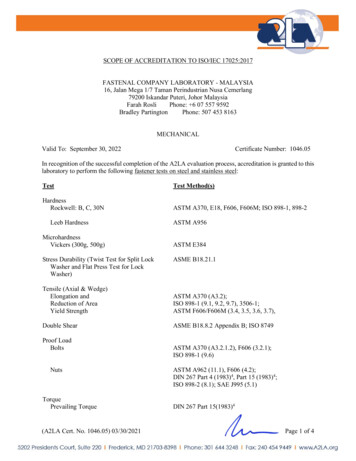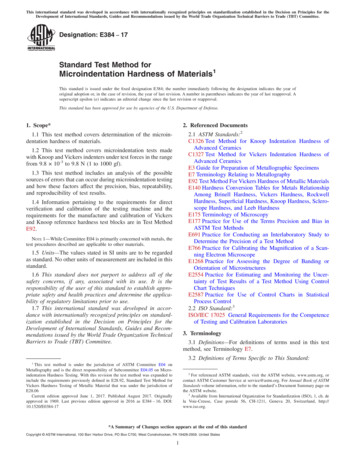
Transcription
This international standard was developed in accordance with internationally recognized principles on standardization established in the Decision on Principles for theDevelopment of International Standards, Guides and Recommendations issued by the World Trade Organization Technical Barriers to Trade (TBT) Committee.Designation: E384 17Standard Test Method forMicroindentation Hardness of Materials1This standard is issued under the fixed designation E384; the number immediately following the designation indicates the year oforiginal adoption or, in the case of revision, the year of last revision. A number in parentheses indicates the year of last reapproval. Asuperscript epsilon ( ) indicates an editorial change since the last revision or reapproval.This standard has been approved for use by agencies of the U.S. Department of Defense.2. Referenced Documents1. Scope*2.1 ASTM Standards:2C1326 Test Method for Knoop Indentation Hardness ofAdvanced CeramicsC1327 Test Method for Vickers Indentation Hardness ofAdvanced CeramicsE3 Guide for Preparation of Metallographic SpecimensE7 Terminology Relating to MetallographyE92 Test Method For Vickers Hardness of Metallic MaterialsE140 Hardness Conversion Tables for Metals RelationshipAmong Brinell Hardness, Vickers Hardness, RockwellHardness, Superficial Hardness, Knoop Hardness, Scleroscope Hardness, and Leeb HardnessE175 Terminology of MicroscopyE177 Practice for Use of the Terms Precision and Bias inASTM Test MethodsE691 Practice for Conducting an Interlaboratory Study toDetermine the Precision of a Test MethodE766 Practice for Calibrating the Magnification of a Scanning Electron MicroscopeE1268 Practice for Assessing the Degree of Banding orOrientation of MicrostructuresE2554 Practice for Estimating and Monitoring the Uncertainty of Test Results of a Test Method Using ControlChart TechniquesE2587 Practice for Use of Control Charts in StatisticalProcess Control2.2 ISO Standard:3ISO/IEC 17025 General Requirements for the Competenceof Testing and Calibration Laboratories1.1 This test method covers determination of the microindentation hardness of materials.1.2 This test method covers microindentation tests madewith Knoop and Vickers indenters under test forces in the rangefrom 9.8 10-3 to 9.8 N (1 to 1000 gf).1.3 This test method includes an analysis of the possiblesources of errors that can occur during microindentation testingand how these factors affect the precision, bias, repeatability,and reproducibility of test results.1.4 Information pertaining to the requirements for directverification and calibration of the testing machine and therequirements for the manufacture and calibration of Vickersand Knoop reference hardness test blocks are in Test MethodE92.NOTE 1—While Committee E04 is primarily concerned with metals, thetest procedures described are applicable to other materials.1.5 Units—The values stated in SI units are to be regardedas standard. No other units of measurement are included in thisstandard.1.6 This standard does not purport to address all of thesafety concerns, if any, associated with its use. It is theresponsibility of the user of this standard to establish appropriate safety and health practices and determine the applicability of regulatory limitations prior to use.1.7 This international standard was developed in accordance with internationally recognized principles on standardization established in the Decision on Principles for theDevelopment of International Standards, Guides and Recommendations issued by the World Trade Organization TechnicalBarriers to Trade (TBT) Committee.3. Terminology3.1 Definitions—For definitions of terms used in this testmethod, see Terminology E7.3.2 Definitions of Terms Specific to This Standard:1This test method is under the jurisdiction of ASTM Committee E04 onMetallography and is the direct responsibility of Subcommittee E04.05 on Microindentation Hardness Testing. With this revision the test method was expanded toinclude the requirements previously defined in E28.92, Standard Test Method forVickers Hardness Testing of Metallic Material that was under the jurisdiction ofE28.06Current edition approved June 1, 2017. Published August 2017. Originallyapproved in 1969. Last previous edition approved in 2016 as E384 – 16. DOI:10.1520/E0384-172For referenced ASTM standards, visit the ASTM website, www.astm.org, orcontact ASTM Customer Service at service@astm.org. For Annual Book of ASTMStandards volume information, refer to the standard’s Document Summary page onthe ASTM website.3Available from International Organization for Standardization (ISO), 1, ch. dela Voie-Creuse, Case postale 56, CH-1211, Geneva 20, Switzerland, http://www.iso.org.*A Summary of Changes section appears at the end of this standardCopyright ASTM International, 100 Barr Harbor Drive, PO Box C700, West Conshohocken, PA 19428-2959. United States1
E384 173.2.1 calibrating, v—determining the values of the significant parameters by comparison with values indicated by areference instrument or by a set of reference standards.3.2.2 Knoop hardness number, HK, n—an expression ofhardness obtained by dividing the force applied to the Knoopindenter by the projected area of the permanent impressionmade by the indenter.3.2.3 Knoop indenter, n—a rhombic-based pyramidalshaped diamond indenter with edge angles of / A 172 30'and / B 130 0' (see Fig. 1).3.2.4 microindentation hardness test, n—a hardness testusing a calibrated machine to force a diamond indenter ofspecific geometry into the surface of the material beingevaluated, in which the test forces range from 1 to 1000 gf (9.8 10-3 to 9.8 N), and the indentation diagonal, or diagonals, aremeasured with a light microscope after load removal; for anymicroindentation hardness test, it is assumed that the indentation does not undergo elastic recovery after force removal.geometrical variations between diamond indenters, and humanerrors in measuring indentation lengths will affect the precisionof the calculated material hardness. The magnitude of the errorthat variations of each of these parameters have on thecalculated value of a microindentation measurement is discussed in Section 10.3.3.1 For Knoop hardness tests, in practice, test loads are ingrams-force and indentation diagonals are in micrometers. TheKnoop hardness number is calculated using the following:NOTE 2—Use of the term microhardness should be avoided because itimplies that the hardness, rather than the force or the indentation size, isvery low.force, gf,length of long diagonal, µm,projected area of indentation, µm 2included longitudinal edge angle, 172 30’included transverse edge angle, 130 0’ (see Fig. 1and, indenter constant relating projected area of the indentation to the square of the length of the long diagonal,ideally 0.07028.HK 5 1.000 3 103 3 P/A p ! 5 1.000 3 103 3 P/ c p 3 d 2 !(1)HK 5 14229 3 P/d 2(2)/B2cp 5/A2tan2(3)ortanwhere:P d Ap /A /B 3.2.5 verifying, v—checking or testing the instrument toassure conformance with the specification.3.2.6 Vickers hardness number, HV, n—an expression ofhardness obtained by dividing the force applied to a Vickersindenter by the surface area of the permanent impression madeby the indenter.3.2.7 Vickers indenter, n—a square-based pyramidal-shapeddiamond indenter with face angles of 136 (see Fig. 2).cp3.3.2 The Knoop hardness, kgf/mm2 is determined as follows:3.3 Formulae—The formulae presented in 3.3.1 – 3.3.4 forcalculating microindentation hardness are based upon an idealtester and conditions. The measured value of the microindentation hardness of a material is subjected to several sources oferrors. Based on Eq 1-9, variations in the applied force,HK 5 14.229 3 P 1 /d 1 2where:P1 force, kgf, andd1 length of long diagonal, mm.FIG. 1 Knoop Indenter2(4)
E384 17FIG. 2 Vickers Indenter3.4 Equations for calculating % Error and Repeatability forperiodic verification is determined as follows:3.3.3 The Knoop hardness reported with units of GPa isdetermined as follows:HK 5 0.014229 3 P 2 /d 2 2(5)E 5 100where:P2 force, N, andd2 length of the long diagonal of the indentation, mm.(6)HV 5 1854.4 3 P/d 2(7)SR 5 100orwhere:P As d α D(10)d max 2 d mind̄D(11)where:R repeatability in performance of the periodicverification,dmax the longest diagonal length measurement on thestandardized test block, µm,dmin the shortest diagonal length measurement on thestandardized test block, µm, andd̄ the measured mean diagonal length in µm.force, gf,surface area of the indentation, µm2,mean diagonal length of the indentation, µm, andface angle of the indenter, 136 0’ (see Fig. 2).3.3.5 The Vickers hardness, kgf/mm2 is determined asfollows:HV 5 1.8544 3 P 1 /d 1 2d̄ 2 d refd refwhere:E % error in performance of the periodic verification,d̄ the measured mean diagonal length in µm, anddref the reported certified mean diagonal length, µm.3.3.4 For the Vickers hardness test, in practice, test loads arein grams-force and indentation diagonals are in micrometers.The Vickers hardness number is calculated as follows:HV 5 1.000 3 103 3 P/A s 5 2.000 3 103 3 Psin α/2 ! /d 2S4. Summary of Test Method(8)4.1 In this test method, a hardness number is determinedbased on the formation of a very small indentation by application of a relatively low force, in comparison to traditionalbulk indentation hardness tests.3.3.6 The Vickers hardness reported with units of GPa isdetermined as follows:4.2 A Knoop or Vickers indenter, made from diamond ofspecific geometry, is pressed into the test specimen surfaceunder an applied force in the range of 1 to 1000 gf using a testmachine specifically designed for such work.where:P1 force, kgf, andd1 mean diagonal length of the indentations, mm.HV 5 0.0018544 3 P 2 /d 2 2(9)where:P2 force, N, andd2 mean diagonal length of the indentations, mm.4.3 The size of the indentation is measured using a lightmicroscope equipped with a filar type eyepiece, or other typeof measuring device (see Terminology E175).3
E384 17Knoop hardness is not normally used to define bulk hardness,except at 500 gf where E140 gives conversions to other testscales, and Knoop tests should not be performed at test forcesabove 1000 gf. The majority of Knoop tests of case hardnessvariations are conducted at forces from 100 to 500 gf. If the testis being conducted to meet a specified bulk hardness value,such as HRC, then most such tests will be conducted withKnoop at a 500 gf load. Because of the large differencebetween the long and short Knoop diagonals, the Knoopindenter is often better suited for determining variations ofhardness over very small distances compared to the Vickersindenter. Vickers and Knoop tests at forces 25 gf aresusceptible to imprecision due to the difficulty in measuringextremely small indents ( 20 µm) by light microscopy withhigh precision and reproducibility. Tests made at forces 25 gfshould be considered to be qualitative in nature. Likewise, testforces that create indents 20 µm in length should be avoidedwhenever possible and should be considered to be qualitativein nature. The success of the specimen preparation procedure inremoving preparation-induced damage can, and will, influencetest results; this problem becomes more critical as the test forcedecreases.4.4 The Knoop hardness number is based upon the forcedivided by the projected area of the indentation. The Vickershardness number is based upon the force divided by the surfacearea of the indentation.4.5 It is assumed that elastic recovery does not occur whenthe indenter is removed after the loading cycle, that is, it isassumed that the indentation retains the shape of the indenterafter the force is removed, but this is not always true. In Knooptesting, it is assumed that the ratio of the long diagonal to theshort diagonal of the impression is the same as for the indenter,7.114, but this is not always true due to elastic recovery.5. Significance and Use5.1 Hardness tests have been found to be very useful formaterials evaluation, quality control of manufacturing processes and research and development efforts. Hardness, although empirical in nature, can be correlated to tensile strengthfor many metals and alloys, and is also an indicator ofmachinability, wear resistance, toughness and ductility.5.2 Microindentation tests are utilized to evaluate and quantify hardness variations that occur over a small distance. Thesevariations may be intentional, such as produced by localizedsurface hardening, for example, from shot blasting, colddrawing, flame hardening, induction hardening, etc., or fromprocesses such as carburization, nitriding, carbonitriding, etc.;or, they may be unintentional variations due to problems, suchas decarburization, localized softening in service, or fromcompositional/microstructural segregation problems. Low testforces also extend hardness testing to materials too thin or toosmall for macroindentation tests. Microindentation tests permithardness testing of specific phases or constituents and regionsor gradients too small for evaluation by macroindentation tests.6. Apparatus6.1 Test Machine—The test machine must support the testspecimen and control the movement of the indenter into thespecimen under a preselected test force, and should have a lightoptical microscope to select the desired test locations and tomeasure the size of the indentations produced by the test. Theplane of the surface of the test specimen must be perpendicularto the axis of the indenter and the direction of the forceapplication. The plane of the test specimen surface must be flat,and free of surface relief, in order to obtain valid, usable testdata. The hardness test machine must meet the verificationrequirements defined in Test Method E92.6.1.1 Force Application—The test machine shall be capableof applying the test forces according to the following:6.1.1.1 The time from the initial application of the forceuntil the full test force is reache
2 For referenced ASTM standards, visit the ASTM website, www.astm.org, or contact ASTM Customer Service at service@astm.org. For Annual Book of ASTM Standards volume information, refer to the standard’s Document Summary page on the ASTM website. 3 Available from International Organization for Standardization (ISO), 1, ch. de la Voie-Creuse, Case postale 56, CH-1211, Geneva 20,
